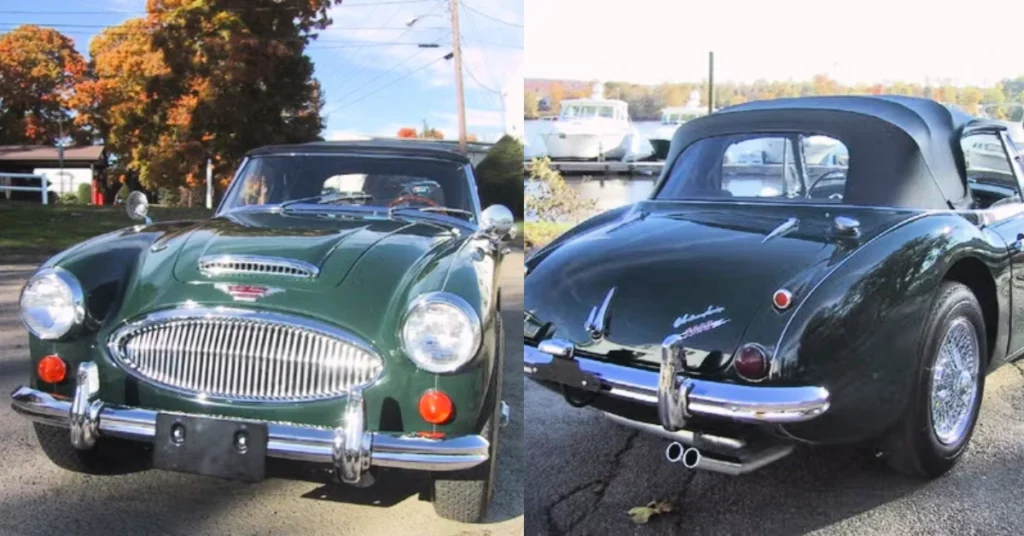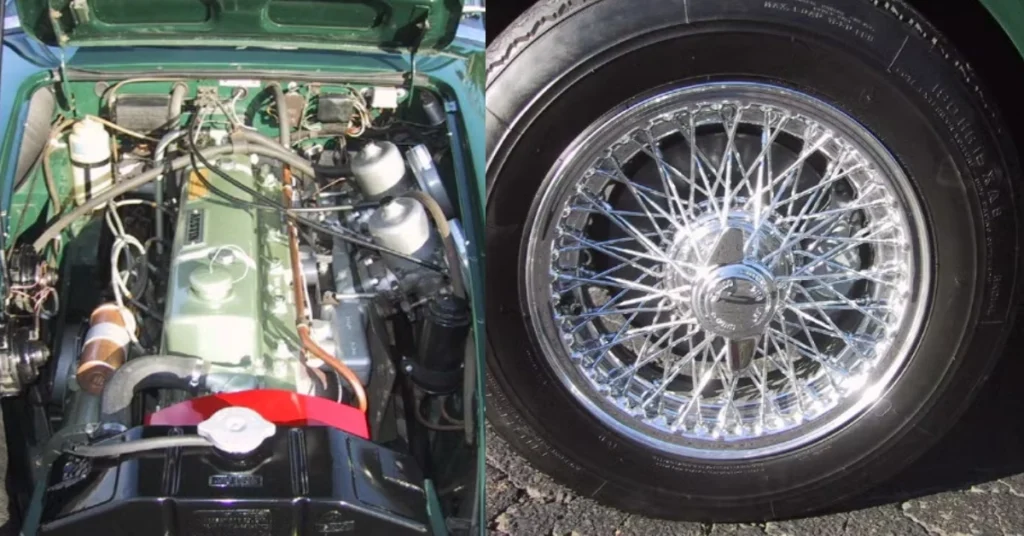Harrison Ford, the Hollywood legend known for iconic roles in Star Wars and Indiana Jones, is not only a master of the silver screen but also a passionate car enthusiast with a deep appreciation for classic vehicles. Among his prized possessions, the 1966 Austin-Healey 3000 MK III stands out as his favorite, a British sports car that embodies elegance, performance, and nostalgia. This article explores the history of the Austin-Healey 3000 MK III, its significance in Ford’s life, its design and performance, and its enduring legacy as a cherished classic in automotive culture.
Table of Contents
The Austin-Healey 3000 MK III: A British Icon
Origins of a Sports Car Legend
The Austin-Healey 3000, introduced in 1959, was the culmination of a collaboration between the British Motor Corporation (BMC) and designer Donald Healey. Building on the success of earlier models like the Austin-Healey 100, the 3000 was a refined sports car that combined spirited performance with classic British styling. The MK III, launched in 1963 and produced until 1967, was the final and most polished iteration, earning a reputation as one of the finest roadsters of its era.
The 1966 model, part of the MK III’s “Phase II” production, arrived during a golden age for British sports cars, competing with rivals like the Jaguar E-Type and MG MGB. Its blend of power, elegance, and open-top driving pleasure made it a favorite among enthusiasts, including high-profile figures like Harrison Ford.
Harrison Ford’s Automotive Passion
Ford’s love for classic cars is well-documented, with a collection that has included American muscle cars and vintage motorcycles. However, the 1966 Austin-Healey 3000 MK III holds a special place in his heart, reflecting his appreciation for craftsmanship and authenticity. Unlike the modern luxury cars favored by many celebrities, Ford’s Healey represents a connection to a simpler, more engaging era of motoring.

Harrison Ford and the Austin-Healey 3000 MK III
A Personal Favorite
Harrison Ford’s affinity for the 1966 Austin-Healey 3000 MK III stems from its timeless design and exhilarating driving experience. As a hands-on enthusiast, Ford is known to enjoy working on his vehicles, and the Healey’s mechanical simplicity makes it an ideal candidate for tinkering. He has reportedly praised the car for its raw, unfiltered feel, which contrasts with the high-tech complexity of modern supercars.
Ford’s Healey is believed to be a well-maintained example, possibly customized to his preferences with period-correct modifications or restored to factory specifications. His ownership adds a layer of celebrity allure, elevating the car’s status among collectors and fans who admire both the actor and the vehicle.
A Reflection of Character
The Austin-Healey 3000 MK III aligns with Ford’s rugged yet refined persona, evoking the adventurous spirit of characters like Han Solo and Indiana Jones. Its open-top design and lively performance offer a sense of freedom and connection to the road, qualities that resonate with Ford’s love for authenticity and exploration. The car’s classic British charm also complements his eclectic tastes, making it a standout in his collection.
The 1970 Pontiac GTO Judge Ram Air IV: The Rarest and Most Exclusive Muscle Car of the 1970s
Carol Burnett’s 1976 Rolls-Royce Silver Shadow: The Timeless Classic That Stole the Spotlight
The 1970 Chevrolet Chevelle SS 454: The Untamed Muscle Car Legend That Defined an Era of Raw Power
Liam Neeson’s 1970 Dodge Challenger: The Iconic Muscle Car That Shined in ‘The Grey’
The 1968 Ford Mustang Mach 1: Hollywood’s Wildest Icon of the 1970s and a Priceless Classic Today
Design and Features of the 1966 Austin-Healey 3000 MK III
Elegant and Sporting Styling
The 1966 Austin-Healey 3000 MK III was a vision of classic British design, with a low-slung body, sweeping fenders, and a distinctive chrome grille. Its compact proportions and rounded lines gave it a timeless elegance, while the convertible top and roll-up windows (a new feature for the MK III) added practicality without sacrificing style. The car was often finished in two-tone color schemes, such as Healey Blue over Ivory White, which enhanced its visual appeal.
The interior was a blend of sport and luxury, featuring leather seats, a wood-veneer dashboard, and a classic three-spoke steering wheel. The instrumentation included a speedometer, tachometer, and gauges for fuel, oil, and temperature, all arranged for driver convenience. While not as plush as a Rolls-Royce, the Healey’s cabin offered a refined yet functional environment, perfect for spirited drives.
Engine and Performance
The 1966 Austin-Healey 3000 MK III was powered by a 2.9-liter inline-six engine, producing 150 horsepower and 173 pound-feet of torque. Equipped with twin SU carburetors and a four-speed manual transmission with overdrive, it delivered lively performance for its time. The engine’s smooth power delivery and distinctive exhaust note made every drive an event, capable of reaching 0 to 60 mph in about 8.5 seconds and a top speed of 120 mph.
The Healey’s rear-wheel-drive layout, combined with a well-tuned suspension featuring front coils and rear leaf springs, provided nimble handling and a balanced ride. While not as sharp as modern sports cars, it offered engaging dynamics for winding country roads, a favorite pastime for owners like Ford.
Performance and Driving Experience
An Exhilarating Open-Top Drive
Driving the 1966 Austin-Healey 3000 MK III was a sensory delight, blending the thrill of open-top motoring with responsive performance. The inline-six engine provided ample power for cruising and overtaking, while the manual transmission and overdrive allowed for precise control. The car’s lightweight construction—around 2,600 pounds—enhanced its agility, making it a joy to pilot through curves.
For Harrison Ford, the Healey offered a visceral connection to the road, with the wind-in-the-hair experience and mechanical feedback that modern cars often lack. Its firm suspension and direct steering required driver involvement, adding to the sense of adventure on every journey.
Reliability and Maintenance
The Austin-Healey 3000 MK III was built to be robust, but its British engineering came with quirks. Regular maintenance, such as tuning the carburetors and checking the electrical system, was essential to keep it running smoothly. Rust was a common issue, particularly in wet climates, but well-preserved examples like Ford’s are reliable with proper care. A strong aftermarket for parts and a dedicated enthusiast community make restoration and upkeep feasible, ensuring the Healey remains roadworthy.

Cultural Impact and Legacy
A Symbol of British Motoring
The 1966 Austin-Healey 3000 MK III is celebrated as one of the quintessential British sports cars, embodying the spirit of open-road freedom. Its appearances in films, TV shows, and classic car rallies have made it a cultural icon, revered by enthusiasts worldwide. Harrison Ford’s ownership adds a layer of Hollywood prestige, linking the car to his legacy as a cinematic hero and car aficionado.
The Healey’s influence can be seen in modern sports cars like the Mazda MX-5 Miata, which draws on the same formula of lightweight design and driver engagement. Its timeless appeal continues to inspire automakers and collectors, keeping the spirit of British roadsters alive.
Collectibility and Value
The 1966 Austin-Healey 3000 MK III is a highly sought-after classic, with values reflecting its desirability and condition. Well-maintained examples typically range from $50,000 to $80,000, while concours-quality or celebrity-owned cars, like Ford’s, can fetch $100,000 or more at auction. The model’s limited production—fewer than 18,000 MK IIIs were built—combined with its iconic status, ensures its value continues to rise, particularly for low-mileage or restored examples.
The Austin-Healey’s Enduring Appeal
A Classic That Captures the Soul
The 1966 Austin-Healey 3000 MK III remains a symbol of elegance and performance, resonating with enthusiasts like Harrison Ford who value authenticity over modern luxury. Its graceful design, spirited driving dynamics, and rich heritage make it a standout in the world of classic cars, cherished at rallies, shows, and scenic drives.
Lessons for Modern Automakers
The Healey’s success underscores the enduring appeal of simple, driver-focused vehicles. As automakers embrace electric and autonomous technologies, the Austin-Healey 3000 MK III reminds us of the joy of driving and the emotional connection that classic cars inspire, qualities that remain timeless.
Conclusion
The 1966 Austin-Healey 3000 MK III is more than a car—it’s a masterpiece that captured Harrison Ford’s heart and continues to enchant classic car enthusiasts worldwide. Its elegant design, exhilarating performance, and connection to a Hollywood icon make it a true treasure of automotive history. Whether cruising along coastal roads or displayed at a car show, the Austin-Healey 3000 MK III proves that some classics outshine even the most modern luxuries, leaving a legacy that endures.

